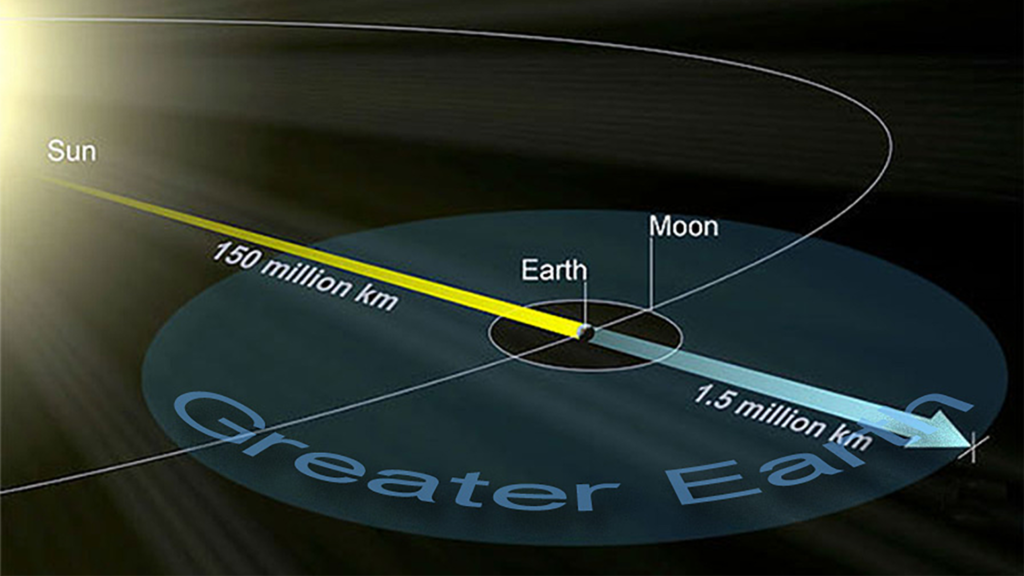A New Perception of Our Planet
In the 20th century humans began to investigate ways to penetrate the atmosphere. Today a communications apparatus installed beyond the atmosphere permits us to remain in constant touch with each other from any place on the planet. Orbital outposts are providing the information to enable human beings to adapt to this new environment. Scientific instruments placed in this area are exploring the depths of the cosmos and investigating the state of the environment on the planet below. National security systems have placed monitoring devices that track developments and movements of opponents making surprise attacks less likely. Indeed, the functioning of contemporary society is totally dependent on these technological resources orbiting the Earth and without them modern civilization would no longer function. These activities have effectively expanded the physical territory of planet Earth from its solid dimensions of 12,756 kilometers to a diameter of approximately 84,328 kilometers which encompasses geosynchronous orbit creating a ring around our planet that may last indefinitely.
As the 21st century unfolds, humanity finds that it needs more room and more resources to sustain its numbers and to maintain its drive for further development. The finite planetary resources that contributed to our present state of civilization are being irrevocably exhausted to unsustainable levels leading to geopolitical conflict and their uncontrolled use within the biosphere is resulting in severe ecological and environmental consequences. As it is unequipped to occupy and transform a neighboring planet to meet its growing needs, humanity's next logical step will be to discover and inhabit the last reaches of its own planet - to expand its activities to Earth's true boundaries as defined by the laws of physics and celestial mechanics.

Greater Earth Diagram
All celestial bodies of significant concentrated mass exert a field of gravitational attraction around their cores which extends to the point of tangential intersection with other celestial bodies. Earth's gravitational influence extends 1.5 million kilometers in all directions from its center where it meets the gravitational influence of the Sun. This sphere, with a diameter of 3 million kilometers, has 13 million times the volume of the physical Earth and through it, passes some more than 55,000 times the amount of solar energy which is available on the surface of the planet. In addition to energy, within this sphere are enormous amounts of other resources, including the Moon and occasional passing asteroids.
Like the territorial waters surrounding nations, these resources naturally belong to our planet and should be used for the ultimate benefit of humanity and all life which has originated here. As it has throughout its history, humanity must understand and seek nourishment from its home planet and it must now once again refine its perception of the planet in order to recognize and embrace the perception of a greater, richer and more sustainable Earth.
This new perception is called Greater Earth. Within its boundaries our species will find the necessary room, resources, opportunities and inspiration that it will need to survive and prosper in the current millennium. Awareness of Greater Earth unites the immense potential of space development with the critical terrestrial issues of ecological sustainability, environmental restoration, clean energy generation, global prosperity and international security. Occupying the area of Greater Earth will make humanity universally conscious of its responsibility to all life sharing its home planet and of the crucial role of the human species in the evolution of life on Earth and beyond. This transformation will reveal humanity’s ultimate purpose in the universe.
The Greater Earth System

The Sun - Earth - Moon system of Greater Earth
Greater Earth is not only a region defined by celestial mechanics and the laws of physics but is also an interdependent dynamic system that contributed to the emergence and evolution of life on Earth. Understanding the dynamic nature of this extended region of Earth and how it has functioned in a unique and incredible manner, adds insight on the future role of the human species in the evolution of life on Earth and in its relation to the Cosmos.
